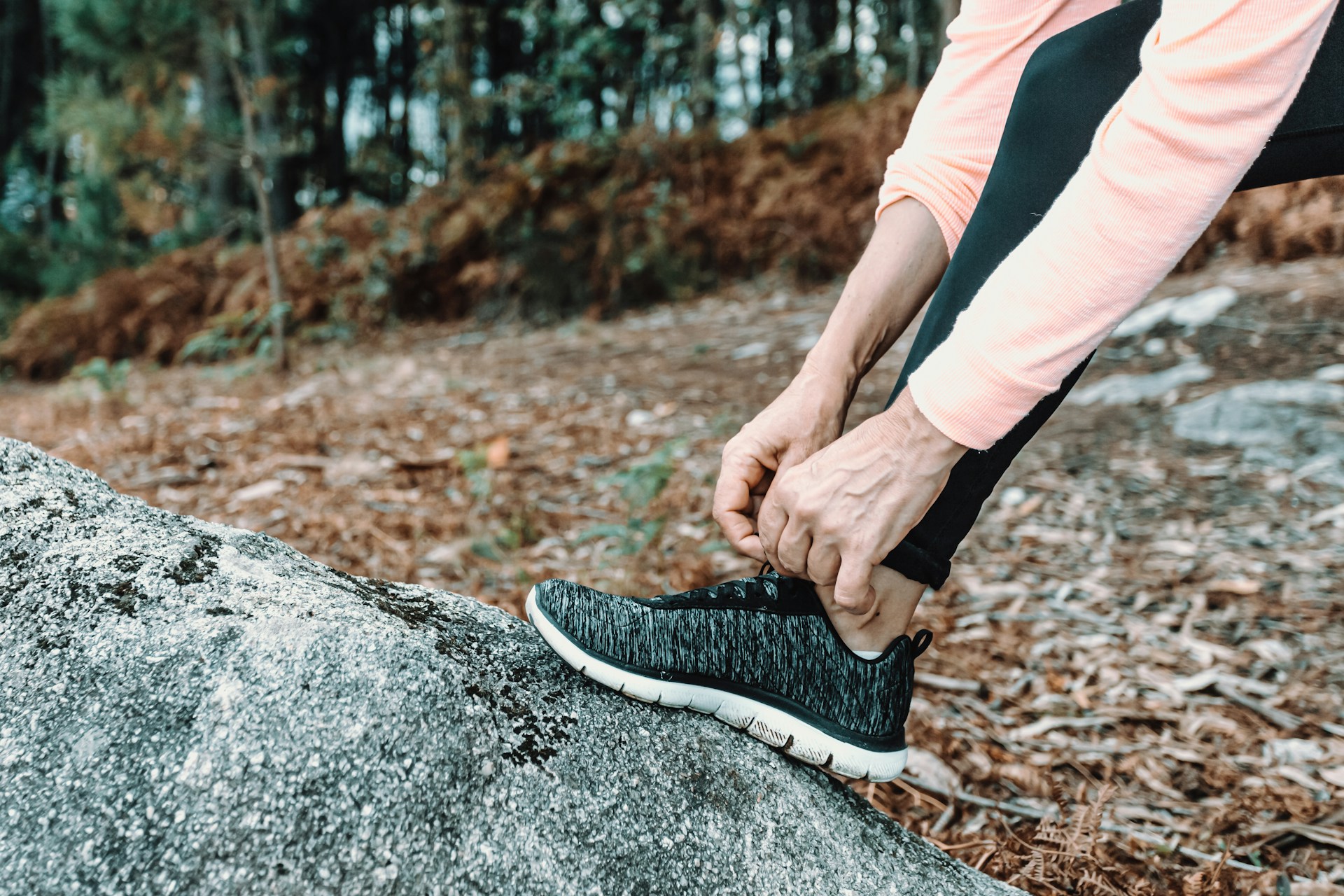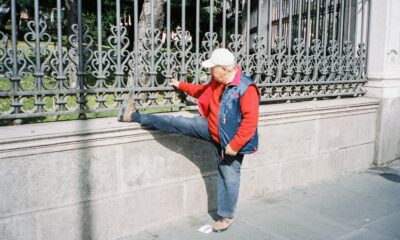Movement
Discover the Gentle Exercise That Soothes Achy Joints

Millions of individuals across the United States experience joint pain, often due to conditions like arthritis. According to Harvard Health, simply ignoring this discomfort is not a viable solution. They emphasize, “Ignoring the pain won’t make it go away. Nor will avoiding all motions that spark discomfort.” Instead, they suggest that avoiding movement can actually weaken muscles, exacerbate joint issues, and negatively impact posture, leading to further complications. While painkillers and hot or cold packs can provide immediate relief, these solutions are only temporary.
For those seeking a more sustainable method of alleviating joint pain, aquatic exercise emerges as an excellent option. This form of low-impact exercise is not only safe but also highly effective. Lauren Shroyer, MS, explains, “Exercise in the water removes the impact stress of ground reaction force.” This means that for individuals with inflamed and painful joints during weight-bearing activities, water-based exercises allow for movement without the adverse effects of impact.
Water exercises also offer resistance, which helps strengthen muscles and reduce joint discomfort. Additionally, they enhance mobility and cardiovascular health. Julie Mulcahy, DPT, notes, “It allows you to perform movement with an arthritic joint that would be painful on land, which then helps improve strength and flexibility in that joint.” Many individuals with chronic joint conditions report feeling liberated from their limitations when exercising in water.
Beyond physical benefits, water therapy also promotes mental well-being. Engaging in aquatic activities can trigger the release of endorphins, which boost mood. Julie See, director of education at the Aquatic Exercise Association, highlights the calming effect of water, stating, “Incorporating diaphragmatic breathing into your aquatic activities can help you relax by stimulating the vagus nerve and activating the parasympathetic nervous system, also known as the rest and digest systems.”
Aquatic exercises not only improve joint health but also enhance balance, which is particularly beneficial for older adults. Michael Murray, president of the APTA Academy of Aquatic Physical Therapy, explains, “Practicing balance in a pool allows you more time to react if you do lose your balance, and by training your muscles to react to waves in the water, you’ll build confidence and lessen your fear of falling on land.” Beginners can start with simple activities like walking in the water and progress to more advanced exercises such as marching in place and standing on one leg.
It’s important to approach aquatic exercise with patience and gradually build endurance. The Mayo Clinic advises, “You might feel some pain and stiffness after exercise if you haven’t been active for a while. In general, if pain lasts more than two hours after exercise, you might be pushing too hard.”
Water aerobics are also particularly suitable for those who are overweight and wish to avoid additional joint stress. Murray points out, “When you exercise in water, you put less weight on your joints, making it possible, if you’re carrying extra weight, to increase your endurance and spend more time working out.” This makes aquatic exercise a versatile and accessible option for many people looking to improve their joint health.
Let us know what you think, please share your thoughts in the comments below.

Movement
Unlock Instant Motivation Experts Share Top Tips to Get You Moving

Finding the drive to accomplish tasks or pursue goals can be challenging, especially when feeling overwhelmed or burned out. Motivation can dwindle for various reasons, including stress, anxiety, and confidence issues. Fortunately, experts have shared some effective strategies to boost motivation instantly. Let’s explore these techniques and how they can help you get back on track.
Move with Others
Engaging in physical activity with others can be a powerful motivator. Health psychologist Kelly McGonigal explains that moving with like-minded individuals fosters a sense of possibility that extends beyond oneself.
“When you move with other people it creates a strong sense of ‘bigger than self’ possibility that makes people feel more optimistic and empowered,” McGonigal shares.
This communal experience can enhance self-confidence and provide a sense of shared purpose in overcoming life’s challenges.
Exercise for Mood Enhancement
Exercise is a natural mood booster, particularly beneficial for those experiencing depression. Dr. Michael Craig Miller, assistant professor of psychiatry at Harvard Medical School, notes that exercise can be as effective as antidepressants for some individuals.
“Start with five minutes a day of walking or any activity you enjoy,” he advises.
Gradually increasing this time can lead to significant improvements in motivation and mood.
Improve Focus with Physical Activity
If you’re struggling to concentrate, exercise might be the answer. Wendy Suzuki, PhD, a neuroscientist and professor at New York University, discovered that a single workout enhances the ability to shift and focus attention.
“This is an immediate benefit that can last for at least two hours after 30 minutes of exercise,” Suzuki states.
Activities like brisk walking, running, or swimming are recommended to get your heart rate up and improve focus.
Release Happy Hormones
Physical activity triggers the release of neurotransmitters that elevate mood and reduce anxiety. Dr. Suzuki highlights that even short bursts of exercise can have a positive impact.
“It only takes between 10 and 30 minutes of daily physical activity to instantly lift your mood,” she explains.
Simple activities like taking a walk or using stairs can suffice if time is limited.
Boost Creativity Through Movement
Exercise can also stimulate creativity. Alex McIntos, creative director of Create Sustain, relies on running and walking to clear his mind and generate new ideas.
“If I don’t exercise, I can really feel the difference,” McIntos says.
A quick walk can often dispel feelings of stagnation and frustration, allowing creativity to flow.
Take a Break for Inspiration
Sometimes, stepping away from a task can reignite motivation. Prof Kathryn Williams, an environmental psychologist, suggests that taking breaks can facilitate creative thinking.
“It is during mind-wandering… that we are most likely to draw connections between diverse ideas and have novel thoughts,” Williams explains.
Allowing your mind to wander during a break can lead to fresh insights and renewed motivation.
Finding motivation can feel like an uphill battle, but these expert-backed techniques offer practical solutions. Whether it’s moving with others, engaging in exercise, or simply taking a break, these strategies can help you regain your drive and tackle your goals with renewed energy.
Let us know what you think, please share your thoughts in the comments below.
Movement
Ease Your Lower Back Pain with These Simple Stretches for a More Comfortable You

Lower back pain is a common issue that can disrupt daily life, but incorporating simple stretches into your routine can provide significant relief. Staying active is one of the most effective and affordable ways to alleviate or prevent lower back discomfort. Let’s explore eight easy stretches that target this area, offering a path to comfort and mobility.
Knee-to-Chest Stretch
The knee-to-chest stretch is a gentle way to elongate the lower back muscles. Lie on your back, bring one knee towards your chest, and hold it with both hands. This position helps to relieve tension in the lumbar spine.
Cat-Cow Stretch
The Cat-Cow stretch is a classic yoga pose that promotes flexibility and strength in the spine. Begin on your hands and knees, then alternate between arching your back like a cat and dropping your belly like a cow. This movement encourages better spinal alignment and eases tension.
Child’s Pose
Child’s Pose is a restorative stretch that gently elongates the lower back. Kneel on the floor, sit back on your heels, and stretch your arms forward. This pose provides a calming effect while relieving lower back pressure.
Seated Forward Bend
The Seated Forward Bend targets the hamstrings and lower back. Sit with your legs extended and reach towards your toes. This stretch not only eases tightness in the lower back but also enhances flexibility in the hamstrings and hip flexors.
Piriformis Stretch
The piriformis stretch is beneficial for those experiencing sciatic pain. Lie on your back, cross one leg over the other, and gently pull the uncrossed leg towards your chest. This stretch targets the piriformis muscle, helping to alleviate lower back discomfort.
Hip Flexor Stretch
Tight hip flexors can contribute to lower back pain. To stretch them, kneel on one knee with the other foot in front, creating a 90-degree angle. Lean forward slightly to feel a stretch in the hip flexor of the kneeling leg.
Pelvic Tilt
The pelvic tilt is a subtle movement that strengthens the lower back. Lie on your back with your knees bent and feet flat on the floor. Tighten your abdominal muscles and tilt your pelvis upward, flattening your back against the floor.
Supine Spinal Twist
The Supine Spinal Twist is a relaxing stretch that targets the entire spine. Lie on your back, bring one knee across your body, and let it drop to the side. This twist helps to relieve tension and improve spinal mobility.
These stretches are simple yet effective tools for alleviating lower back pain. Incorporating them into your routine can enhance flexibility, reduce discomfort, and promote overall well-being. Remember, staying active is one of the best ways to maintain a healthy back and prevent future pain.
Let us know what you think, please share your thoughts in the comments below.
Movement
Revamp Your Walk: Boost Health with These 5 Key Steps

Starting your day with a brisk walk can do wonders for your health and weight loss goals. Walking is not only easy and accessible, but it also has a host of benefits for your cardiovascular system, lung strength, and metabolism. Here are five ways to enhance your daily walk, making it a powerful tool for shedding those extra pounds and improving your overall well-being.
Wear the Right Gear
Before you even step outside, make sure you’re equipped with a good pair of walking shoes. This simple investment can make a world of difference in your comfort and performance.
“All you need is a good pair of walking shoes,” says a seasoned fitness expert. Proper footwear can help prevent injuries and make your walk more enjoyable.
Track Your Heart Rate
Monitoring your heart rate can significantly improve the effectiveness of your walking routine. A heart rate monitor can be a valuable tool in understanding your workout intensity.
“I love the MYZONE because it’s so simple and easy,” the expert comments. By keeping your heart rate within 70-80% of your maximum (calculated as 220 minus your age), you can maximize your aerobic capacity and fat burning.
Start Slow and Build Gradually
It’s crucial to ease into any new exercise program to avoid injury and ensure long-term success. Start by walking short distances and gradually increase both the duration and intensity of your walks over a period of 4-6 weeks.
“The goal is to increase your baseline fitness with maybe 4-6 weeks of building up endurance and distance by slowly adding to these variables and taking baby steps,” advises the expert.
Schedule Walks with Friends
One surefire way to stick to your walking routine is to make it social. Research shows that people are more likely to follow through with exercise when they know someone is counting on them.
“It’s an ‘appointment,’ and someone is counting on you to show up!” says the fitness expert. Scheduling walks with a friend or family member can make your exercise more enjoyable and keep you accountable.
Combine Walking with a Healthy Diet
Exercise alone won’t lead to significant weight loss if it’s not paired with a balanced diet. Pay attention to what you’re eating and drinking each day to ensure you’re burning more calories than you consume.
“The overall goal is burning calories, whether they are from fat or from carbohydrates,” the expert points out. Monitoring your diet can amplify the benefits of your walking routine, helping you achieve and maintain your weight loss goals.
Walking is a fantastic way to boost your health and aid in weight loss. By following these five tips, you can turn your daily walk into a highly effective workout. Remember to be patient with yourself—changes take time, but with consistency, you’ll soon start to see and feel the benefits. So lace up those shoes, grab a friend, and get moving!
Let us know what you think, please share your thoughts in the comments below.
-

 Health6 months ago
Health6 months ago17-Second Neuropathy Solution
-

 Nutrition10 months ago
Nutrition10 months agoThe Aging Secret of Vitamin D Unveiled
-

 Health1 year ago
Health1 year agoPreventing Falls and Injuries for Seniors
-

 Health5 months ago
Health5 months agoOncologist Reveals Top 5 Cancer Prevention Tips You Shouldn’t Ignore
-

 Nutrition1 year ago
Nutrition1 year ago5 AMAZING Dinner Recipes That Are Also HEALTHY
-

 Lifestyle6 months ago
Lifestyle6 months agoSleep Soundly with These 11 Expert-Approved Bedtime Routines
-

 Health11 months ago
Health11 months agoDownsizing Tips: Simplifying Your Lifestyle
-

 Lifestyle3 months ago
Lifestyle3 months agoMorning Habits That Could Add Years to Your Life